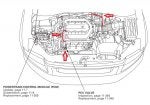All,
While gaining access to my ATF fill plug yesterday I needed to pull the top from the air filter box and the connecting hose to the air intake.
I was alarmed to find oil on the top of the filter (engine side) closest to the intake and also inside the air intake hose. The butterfly for the intake looks clean as did the oil on the filet so this looks recent.
Couple of call outs:
I have an 08 EXVL so there's the oil consumption concern
The air filter only has +/- 15k miles on it (mostly city driving)
Car only has 55k miles on it
2 weeks ago I took it to the Honda dealer to have the timing belt, water pump, idler, drive belt replaced along with a drain/fill for the antifreeze
What are the possible root causes for this? I'm thinking it might be a clogged PCV but am concerned with the history of some of these engines. As the extended power train warranty for this vehicle is 8/80 and it was purchased in July 2008 it's still within that period.
Thanks in advance and I can post pics if needed.
-Eric
I cleaned my throttle body yesterday (2012 6-6). After I disconnected the OEM air intake from the TB, I saw a very light film of oil on that inch of black ribbing between PCV deposit tube and the TB. (As an aside my car has about 40,000 miles on it and the TB and perimeter of the TB valve was dirty. When I manually held open the valve it was slightly black inside. Nothing a heavy dose of carb cleaner, an old toothbrush and a rag couldn't completely clean.) Anyway, I also cleaned that small area of the intake plumbing. As I did this I thought about this thread.
It occurred to me you may NOT have a terrible problem. Consider this:
As a starting point you would think that air moving into the engine would draw all oil from that PCV deposit tube toward the TB. But yet oil made its way to the air filter. How? What about a pressure delay/reversal? For example, you step on the gas. The TB valve opens. RPM and cylinder pressure increase causing “short-term” blow-by. Now the crankcase has that extra pressure. It takes a second or more for that pressure to work its way through the PCV valve and up through that tubing. But now you’ve stopped accelerating and taken your foot off the gas. The TB valve is nearly closed and almost zero air is being drawn through the air intake. But the PCV valve is still releasing pressure pushing that oil residue into the intake plumbing.
What happens to that oil? Does it sucked into the engine? Perhaps no because there’s no air movement. That oil may just puddle in the ribbing. And if your engine has a blow-by problem you could easily have a few ounces per month accumulate. Once that oil deposits in the tubing, some of it works its way backwards toward the air filter.
I’ve never studied this, but if the TB is open permitting high velocity air into the engine and then closes rapidly, what happens to that column of “still moving” air in the air intake? When it hits the closed TB valve, does that air’s momentum cause it to bounce off and move in the other direction for a split second - toward the filter? (Sort of decompress and expand backwards?) If yes, that potential condition could push the oil toward the filter. I suppose hard right hand turns could also push oil toward the filter. This occasional backwards motion of air might slowly push oil toward the air filter, but after 55,000 miles it could be noticeable.
It seems to me that if you have oil in the intake the PCV valve is working properly. It’s releasing pressure as designed and unfortunately carrying oil with it. There may be nothing more to do than just clean everything every now and then. Get carb cleaner and clean the entire intake tubing, the MAF sensor (take it out and spray it with cleaner), clean the TB, both sides of the brass TB valve, and those first few inches beyond the TB into the manifold. It takes only ten minutes. If you can’t stop the blow-by, this may be all you can do.
And if you happen to spray a LOT of carb cleaner into the TB and manifold, as I did, the engine may not start immediately. I had to crank mine for about five seconds and when it eventually started it idled hard for a second or two. But after I revved it once it ran great. No problems. Food for thought.






